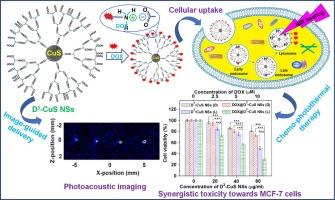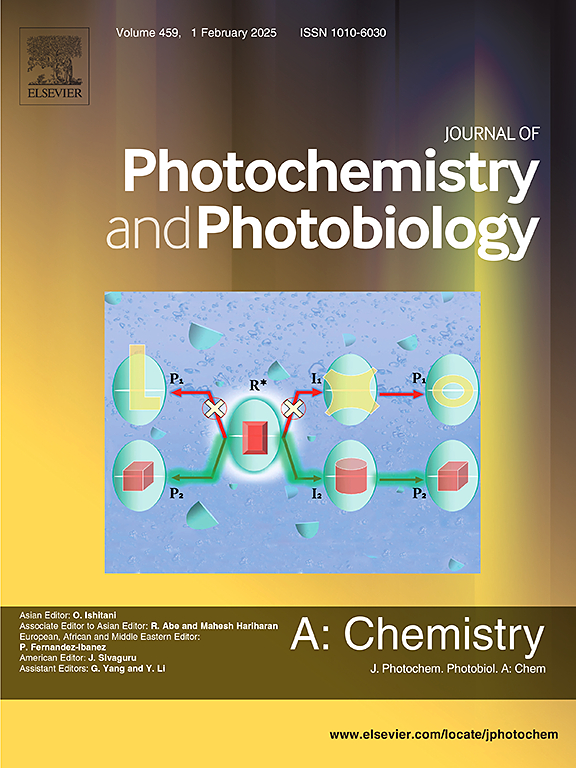Growth of dendritic CuS nanostructures for photoacoustic image guided Chemo-Photothermal therapy
IF 4.1
3区 化学
Q2 CHEMISTRY, PHYSICAL
Journal of Photochemistry and Photobiology A-chemistry
Pub Date : 2024-10-15
DOI:10.1016/j.jphotochem.2024.116084
引用次数: 0
Abstract
Herein, we report a unique method for design and development of carboxyl enriched dendritic CuS nanostructures (CuS NSs) for photoacoustic image guided chemo-photothermal therapy. The dendritic network was grown on the surface of CuS nanoparticles via layer-by-layer assembly of amino acid. XRD and TEM studies established the formation of crystalline well-spherical nanosized hexagonal covellite (CuS) phase. The successful growth of dendritic structure was apparent from the rise in surface charge, hydrodynamic diameter and characteristic vibrational band intensity of peptide bonds. The developed different generations of dendritic CuS NSs (D0-CuS NSs, D1-CuS NSs, D2-CuS NSs and D3-CuS NSs) displayed wide-ranging absorption band in near infrared (NIR) zone and exhibited good photothermal heating efficacy upon irradiation of 980 nm laser light. From in-vitro cellular studies, it has been found that the NIR irradiation effectively enhanced the photothermal toxicity of D3-CuS NSs towards cancer cells. Moreover, these negatively charged water-dispersible D3-CuS NSs were conjugated with positively charged anticancer drug, doxorubicin hydrochloride (DOX) through electrostatic interaction. The DOX loaded D3-CuS NSs (DOX@D3-CuS NSs) revealed pH dependent drug release behaviour and their considerable uptake in breast cancer cells (MCF-7). Further, DOX@D3-CuS NSs exhibited a much higher toxicity towards cancer cells upon NIR light over individual counterparts suggesting their strong ability for chemo-photothermal therapy. Moreover, these biocompatible CuS NSs have shown excellent concentration dependent photoacoustic properties at pulse laser excitation (850 nm) and thus, they can be found potential application in chemo-photothermal therapy.

用于光声图像引导化疗-热疗的树枝状 CuS 纳米结构的生长
在此,我们报告了一种设计和开发富含羧基的树枝状 CuS 纳米结构(CuS NSs)的独特方法,用于光声图像引导的化学光热疗法。树枝状网络是通过逐层组装氨基酸在 CuS 纳米粒子表面生长出来的。XRD 和 TEM 研究证实形成了结晶性良好的球形纳米六方珂罗版石(CuS)相。从表面电荷、流体力学直径和肽键特征振带强度的增加可以明显看出树枝状结构的成功生长。开发出的不同代树枝状 CuS NSs(D0-CuS NSs、D1-CuS NSs、D2-CuS NSs 和 D3-CuS NSs)在近红外(NIR)区显示出广泛的吸收带,并在 980 纳米激光照射下表现出良好的光热加热功效。体外细胞研究发现,近红外辐照可有效增强 D3-CuS NSs 对癌细胞的光热毒性。此外,这些带负电荷的水分散性 D3-CuS NSs 通过静电作用与带正电荷的抗癌药物盐酸多柔比星(DOX)共轭。载入 DOX 的 D3-CuS NSs(DOX@D3-CuS NSs)显示出依赖于 pH 值的药物释放行为及其在乳腺癌细胞(MCF-7)中的大量吸收。此外,在近红外光下,DOX@D3-CuS NSs 对癌细胞的毒性远高于单独的同类产品,这表明它们具有很强的化学光热治疗能力。此外,这些具有生物相容性的 CuS NSs 在脉冲激光激发(850 纳米)下表现出卓越的浓度依赖性光声特性,因此,它们在化疗光热疗法中具有潜在的应用前景。
本文章由计算机程序翻译,如有差异,请以英文原文为准。
求助全文
约1分钟内获得全文
求助全文
来源期刊
CiteScore
7.90
自引率
7.00%
发文量
580
审稿时长
48 days
期刊介绍:
JPPA publishes the results of fundamental studies on all aspects of chemical phenomena induced by interactions between light and molecules/matter of all kinds.
All systems capable of being described at the molecular or integrated multimolecular level are appropriate for the journal. This includes all molecular chemical species as well as biomolecular, supramolecular, polymer and other macromolecular systems, as well as solid state photochemistry. In addition, the journal publishes studies of semiconductor and other photoactive organic and inorganic materials, photocatalysis (organic, inorganic, supramolecular and superconductor).
The scope includes condensed and gas phase photochemistry, as well as synchrotron radiation chemistry. A broad range of processes and techniques in photochemistry are covered such as light induced energy, electron and proton transfer; nonlinear photochemical behavior; mechanistic investigation of photochemical reactions and identification of the products of photochemical reactions; quantum yield determinations and measurements of rate constants for primary and secondary photochemical processes; steady-state and time-resolved emission, ultrafast spectroscopic methods, single molecule spectroscopy, time resolved X-ray diffraction, luminescence microscopy, and scattering spectroscopy applied to photochemistry. Papers in emerging and applied areas such as luminescent sensors, electroluminescence, solar energy conversion, atmospheric photochemistry, environmental remediation, and related photocatalytic chemistry are also welcome.

 求助内容:
求助内容: 应助结果提醒方式:
应助结果提醒方式:


